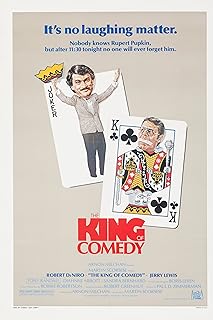喜剧之王/喜剧之王
導演: 馬丁史柯西斯編劇: Paul D. Zimmerman
演員: 勞勃狄尼洛 傑瑞路易 Diahnne Abbott Sandra Bernhard 雪麗海克

2012-11-28 19:53:58
KOC CINEMATIC VARIANTS
************這篇影評可能有雷************
Linking of episodes according to plot-action line:
The linking of episodes generally follows linear story line. But some people suggest that the ending might be a fantasy sequence, which means it follows Rupert's psychological progress rather than reality plot line.
Film scholar David Bordwell, writing in Film Viewer's Guide, mentioned the (un)reality of the ending as a topic for debate. While in my opinion, the repeating "Rupert Pupkin, ladies and gentlemen" with the camera sweep down through packed out theatre and the whole audience waiting for Rupert's triumphant return to stand up makes the ending surreal, like the reverberation of the xylophone heard when Travis adjusts the mirror.
The answer of whether the endings of Taxi Driver or The King of Comedy are real or fantasy doesn't matter. It is meant to confuse us. Scorsese stated that Michael Powell's films influenced The King of Comedy in its conception of fantasy. Powell always treated fantasy as no different than reality, and made fantasy sequences as realistic as possible. Scorsese sought to achieve the same with the film so that, in his words, the "fantasy is more real than reality."
Associative montage; symbolic shots, mood shots, etc:
In this film, Rupert Pupkin's character fails to differentiate between his fantasies and reality, for instance-
Fantasy sequences imply Rupert's psychological needs.
Rupert faces the mirror, fantasizing him having dinner with 傑瑞 while 傑瑞 begs him to host the show;
Rupert fantasizing him in 傑瑞’s office and being praised by 傑瑞 after 傑瑞 has listened to his tape. In the sequence there is a bizarrely honest moment when Rupert is asked, 「how do you do it?」 While he answers, 「I think that its I look at my whole life and I see the awful, terrible things in my life and turn it into something funny.」 This is the first hint about the fact that Pupkin is not totally ignorant towards his frustrated external reality (the second would be him saying "It wasn't that hard...a few minutes of your time to listen to something that I worked on my whole life"), and what he tries to do when communicating with people is not ignoring their messages because of his self-confidence, but artificially recompose the heartbreaking criticisms into something funny, something he wants to hear about.
the 「This is Your Life」 style TV segment in which a world famous Rupert married with his dream girl Rita, and is reunited with his high-school principal, who apologizes for 「all the things that we did to you」 "we are wrong, you are right."
Smooth "imperceptible" transitions from shot to shot:
Generally smooth transitions between shots and scenes. Scorsese filmed The King of Comedy with a calm, documentary-like [IMR?] shooting style, which makes the movie more convincing and "mature" (said by Sergio Leone, Scorsese doesn't think so).
Ebert says that this film "represents an enormous departure for Scorsese... whose camera used to prowl restlessly until he nailed it down this time."
Cutting is jarring, "shocking," use of wipes, superposition of images:
Occasionally abrupt cutting. Ebert states that "Scorsese doesn't direct a single scene for a payoff, the whole movie is an exercise in cinema interruptus," for instance-
the last bar scene when Rupert triumphantly turns on the TV set to reveal himself on television, it is edited to leave out the payoff shots (Rita and other audiences');
Rita steals a trinket from the mantelpiece in 傑瑞's apartment. Again, there is no payoff, this brief piece of story just ends itself;
in the fantasy sequence, Rupert's high-school principal apologizes for 「all the things that we did to you」. But what was done to Rupert is left ambiguous.
Time is drawn out or contracted through montage"
Scorsese doesn't give many payoff scenes in this movie, hence some times are omitted. For instance Rupert's incarceration period. But there are also some scenes that are unrealistically long, for instance the ending--
The shot is carried on long past any semblance of reality, with Rupert simply nodding and soaking in the adulation, while the audience continues to cheer, and the announcer continues to repeat his introductions.
Rythm of montage motivated by internal (diegetic) action:
The action is centred entirely on the characters and their conflict with no room for the niceties of fancy camera angles or movements, or complex editing tricks. It's a film of voices, faces, and physical gestures. While lacking the obvious visual richness of Raging Bull or 紐約 紐約, The King of Comedy's mise en scene is quite deceptive. Things haven't been pared down to essences (Dreyer, Bresson) so much as they've been concentrated for maximum impact (Fuller, Lang), i.e. the airless offices, bland bar rooms, glassy waiting-room (http://ehrensteinland.com/htmls/library/koc.html).
Unusual framing; frame cuts into parts of seen objects:
Opening freeze frame from inside the world of 傑瑞's car, where two hands press hard against the window looking out toward the crazed fans in a mob outside trying to fight their way in. Between the hands peering intensely inside is one eye of our most committed protagonist.
Noticeable obstruction of characters by other characters and objects:
Rupert's mom never appears on screen; their dialogue makes me think of Howard and his mom's in recent popular TV series The Big Bang Theory.
Framing and composition have "candid" quality:
In this film, Scorsese moved away from the expressionist impulse of 1960s and 1970s cinema, aligned himself with the New Hollywood style.
(http://www.thefreelibrary.com/Too+smart,+too+soon%3A+The+King+of+Comedy+and+American+Independent...-a0220469269)
Camera placement/movement dictated by plot-action line:
Scorsese says he wants the audience to see the way he sees, "Walking down the street, looking quickly about, tracking, panning, zooming, cutting..." (Scorsese on Scorsese)
Camera placement/movement (dolly shots, crane shots, etc.) draw attention to themselves and may produce unusual aesthetic effects:
Rupert tapes 傑瑞 to a chair in a funny overhead trademark Scorsese shot.
Nervous, jerky movement, handheld camera; noticeable pans or zoom shots:
the pull back shot (0:34:30) of the laughing audience wallpaper to which Rupert's performing to;
slow zoom-in for the final long take where Rupert dresses in red and stands in the spotlight.
Unexpected, unusual, or unexplained sound effects:
the looping laugh track that plays behind when Rupert's performing to a wallpaper full of laughing faces.
Dialog characterized by unusual pauses; characters stutter or pause to grope for words; other interference:
Rupert constantly refuses to receive other's message or deliberately misunderstands it.

